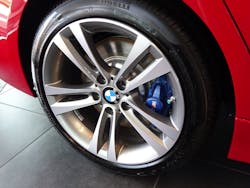Subject: Vehicle Stabilization
Topic: Tire Deflation Challenges
Objective: Understand how run-flat tires, low-profile tires and new thick metal-valve stems can influence our tire-deflation techniques
Task: The rescue team shall demonstrate various methods to effectively stabilize a vehicle when run-flat tires, low-profile tires, and/or new technology metal-valve stems are present.
Opening sidebar:
Tire Deflation Challenges
- Run flat tires
- Low profile tires
- Metal valve stems
In Part 1 of our tire-deflation series, we discussed how important it is that a vehicle be properly stabilized, especially when a patient is trapped in a crash-damaged vehicle. We discussed how, with the vehicle resting on its tires on a level surface, the stabilization task involves three elements: chocking, blocking and blowing the tires.
With the presence of a built-in tire-pressure monitoring system in the vehicle however, it was shown that tire deflation during vehicle stabilization efforts cannot be done by “pulling the valve stems.” The pressure monitor and transmitter unit secured to the base of the valve stem is far too large to be pulled through the small hole in the wheel.
Now in Part 2, we focus on additional tire-deflation challenges that rescue personnel must anticipate. These include run-flat tires, low-profile tires and new technology metal-valve stems.
Encountering run-flat tires at a crash scene can challenge rescue personnel not familiar with the difference between a run-flat tire and a conventional tire that will deflate easily when punctured.
With low-profile tires, the height of the sidewall of the tire is typically very small, so tire deflation generally does not lower the damaged vehicle sufficiently enough to settle it onto your cribbing or step chocks.
The difference between the tires and valve stems on the old cars we cut up in training and the tires we might find on a crashed, late-model vehicle at an incident scene is significant.
The bottom line for responders regarding tire deflation is that actually deflating a tire might not be as simple or as practical as we are accustomed to. All responders should be trained on how to back up to a fender and use their legs to “lift” a vehicle onto the cribbing placed beneath it. This is our default technique, especially when these new tire technologies make deflation of the tire impractical. Lifting might be our only choice.






